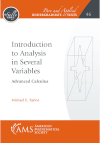- About MAA
- Membership
- MAA Publications
- Periodicals
- Blogs
- MAA Book Series
- MAA Press (an imprint of the AMS)
- MAA Notes
- MAA Reviews
- Mathematical Communication
- Information for Libraries
- Author Resources
- Advertise with MAA
- Meetings
- Competitions
- Programs
- Communities
- MAA Sections
- SIGMAA
- MAA Connect
- Students
- MAA Awards
- Awards Booklets
- Writing Awards
- Teaching Awards
- Service Awards
- Research Awards
- Lecture Awards
- Putnam Competition Individual and Team Winners
- D. E. Shaw Group AMC 8 Awards & Certificates
- Maryam Mirzakhani AMC 10 A Awards & Certificates
- Two Sigma AMC 10 B Awards & Certificates
- Jane Street AMC 12 A Awards & Certificates
- Akamai AMC 12 B Awards & Certificates
- High School Teachers
- News
You are here
Introduction to Analysis in Several Variables: Advanced Calculus

Buy Now:
Publisher:
AMS
Publication Date:
2020
Number of Pages:
445
Format:
Paperback
Series:
Pure and Applied Undergraduate Texts
Price:
85.00
ISBN:
978-1470456696
Category:
Textbook
[Reviewed by , on ]
Jeff Ibbotson
08/27/2023
The all-inclusive title of this book gives an immediate reassurance to those who believe that “Advanced Calculus” and “Real Analysis” are the same things. And well they might since courses of both names are offered at many higher institutions and often leave students scratching their heads and wondering “what’s the difference?”. Back when this reviewer was in graduate school the difference was that “advanced calculus” meant a year-long course primarily for engineers which featured some basic analysis material on continuity and differentiability, the Riemann-Stieltjes Integral and then chapter introductions devoted to Fourier series, Complex Variables, Special Functions and other such things. I suppose it was meant to be “all the math an undergraduate engineering/physics/chemistry student needs to do their job”. Real Analysis, on the other hand, was intended for mathematics majors and put a high demand on rigor (as opposed to computation). One early example of the former course was Philip Franklin’s Treatise on Advanced Calculus. Of the latter, one might see Rudin’s Principles of Mathematical Analysis or Buck’s Advanced Calculus. There have been many others as well. Glancing into any of these might leave one puzzled about the content – it’s the same (in large strokes)! Perhaps it only depends on a given institution’s Mathematics Department and their understanding of the difference (if it exists). A noted change in the last 20 years is an orientation toward differential geometry and much less complex analysis. This book certainly follows that trend.
The author of this book has written a large number of texts (including a lovely text on partial differential equations). This book is a nice addition to the collection and bills itself as accessible to any student who has taken three semesters of calculus and linear algebra. This seems pretty accurate to me – there is attention paid to developing some abstraction (derivatives of matrix groups, the Riemann integral in n dimensions, exterior products of differential forms, and differential geometry up to Gauss-Bonnet) but nothing too abstract (such as long and short exact sequences of groups). Coordinates are used throughout to explain ideas and while this sometimes makes the presentation appear dense with computations it is preferable for students at this stage of development. Many sections are followed by exercise sets that look like modules for developing ideas further. There is a very nice thread that develops degree theory winding through the book as well. It begins with the section on differential forms, then reappears in the discussion of Riemann curvature and finally appears once more in appendix A.7 where it is paired with de Rham theory. One aspect of the computational viewpoint used is that there is no formal definition of tensor product. Could/should this be addressed in an appendix of its own? Maybe. The final chapter on Fourier theory is quite nice and could be used as a short course all on it own. Fourier series and transforms appear at the beginning and the Poisson kernel and spherical harmonics are fully treated with a view toward decomposition of vector spaces of functions. A student who works through this carefully will be well-prepared for a course on Sobolev spaces or Distributions in general. All in all, this book accomplishes its task of preparing students for more abstract modern mathematics while at the same time giving a lucid introduction full of the details for following on to a study of applied mathematics. I heartily recommend it!
Jeff Ibbotson, Ph.D., Mathematics Department, Phillips Exeter Academy.
See the publisher's website.
- Log in to post comments




